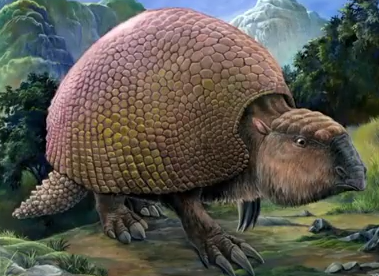Squeaks and I love it when the weather gets warm!
我和吱吱喜欢天气变暖!
We get to have picnics, go to the beach, and spend all day exploring!
我们可以开始去野餐,去海滩,整天探索世界!
But you know, the Earth didn't always get this warm every year.
但你知道的,地球并不总是每年都这么暖和。
It goes through some warmer periods and some colder ones.
它经历过一些温暖时期和冰冷时期。
A very long time ago, the world went through what's called an ice age.
很久以前,地球经历了所谓的冰河时代。
It was so cold that a lot of the Earth's water stayed frozen as ice for most of the year.
那时地球非常寒冷,许多水大部分时间都是冰冻状态。
Most of that ice went away about 12,000 years ago, way before your parents or grandparents were born.
多数冰在大约1万2千年前就消失了,远在你的父母或祖父母出生之前。
But before that, when so much of the world was covered in ice, life looked a little different!
但在此之前,世界上大部分地区都被冰雪覆盖的时候,生命看起来有些不同!
A lot of the same kinds of animals we have today were around then, too.
我们周围现在有很多同种动物当时也存在。
Yes, including rats, Squeaks! But!
是的,吱吱,包括老鼠!但是!
There were also some animals back then that have since died out,
还有一些动物
animals that were much bigger than we're used to.
那些比我们过去大得多的动物后来灭绝了。
If you were to take an ice age tour around the world, you'd meet some pretty wacky characters!
如果你要在冰河时代环游世界,会遇到一些非常古怪的物种!
Imagine meeting a glyptodon, a relative of the armadillo.
想象一下,你遇见了犰狳的近亲——雕齿兽。
That's right, we've learned about armadillos before!
没错,我们之前了解过犰狳。
They're covered in armor to keep them safe from other animals.
它们被盔甲覆盖以免受其他动物的伤害。
The glyptodon looked a lot like an armadillo, and it also had armor, but it was the size of a car!
雕齿兽看起来很像犰狳,它也有盔甲,但体型和汽车一样大!
Some glyptodons even had sharp spikes on their tails.
一些雕齿兽的尾巴上甚至有尖刺。
There were also giant beavers, which could grow to two and a half meters long and weigh 100 kilograms.
那时还有巨大的海狸,它们可以长到2.5米长,100公斤重。
Imagine a cute little beaver, but grown to the size of a bear!
想象一下,一只可爱的小海狸长成了熊的体型!
And there were mastodons and mammoths, both relatives of today's elephants.
还有乳齿象和猛犸象,它们都是现代大象的近亲。
They're all part of the group of animals that have a trunk for a nose.
归属于有象鼻的动物一类。
Mastodons and mammoths had a lot in common:
乳齿象和猛犸象有很多相似之处:
they were both enormous, had long, shaggy hair that kept them warm,
它们都体型巨大,有保温的蓬松长毛,
and had trunks to help them scrape snow and ice off the plants they wanted to eat.
还有象鼻帮助它们刮掉想吃的植物上的冰雪。

But there were also some differences between them.
但它们也有一些不同之处。
For example, mastodons had long, pointed tusks, whereas mammoths had curvy ones.
比如,乳齿象有长而尖的獠牙,而猛犸的獠牙弯曲。
And mastodons had cone-shaped teeth to crush the plants they ate,
乳齿象用锥形牙齿来碾碎植物,
but mammoth teeth looked more like crinkly potato chips, with ridges to help them grind up grass.
但是猛犸象的牙齿看起来更像卷曲的薯片,用槽嵴来磨碎青草。
But you don't have to worry about running into any of these animals on your way to school.
但是你不用担心会在上学的路上碰到这些动物。
By about 10,000 years ago, they had all gone extinct, meaning they weren't around anymore.
大约1万年前,它们已经灭绝了,这意味着它们不再存在了。
And even if you did run into a mastodon or glyptodon, you wouldn't have to worry.
而且即使你遇到了乳齿象或雕齿兽,也不必担心。
Everyone we just met was a herbivore, which means they ate plants, not other animals.
我们刚认识的每种动物都是食草动物,这意味着它们只吃植物,而不吃其他动物。
But some giant animals from the ice age did eat other animals.
但有些来自冰河时代的巨型动物确实吃其他动物。
Smilodon was a big cat that lived in North and South America.
剑齿虎是生活在北美和南美的大型猫科动物。
People sometimes call it a saber-toothed tiger, even though it isn't really a close relative of tigers.
人们有时称它为剑齿虎,尽管它并不是老虎的近亲。
But I bet you can guess where the name "saber-tooth" comes from.
但我敢打赌,你能猜出“saber-tooth”名字的由来。
Smilodon had two giant teeth that were long and curved, almost like a type of sword called a saber.
剑齿虎有两颗长而弯曲的大獠牙,很像一种叫做佩剑的剑。
And smilodons were predators, which means they hunted and ate other animals.
剑齿虎是食肉动物,这意味着它们捕食其他动物。
They probably used their giant saber teeth to hunt the other huge animals that lived around the same time,
它们很可能用它们的巨大剑齿猎食同一时期的其他大型动物。
like mastodons and mammoths.
比如乳齿象和猛犸象。
Then after hunting down their lunch, they had to eat it!
它们扑倒午餐后,不得不吃了它们!
To bite around those giant saber teeth, they were able to open their mouths really wide.
为了用剑齿周围的牙齿撕咬,它们能把嘴巴张得很大。
Smilodons also had a tongue bone, a lot like today's lion.
剑齿虎也有一根舌骨,很像今天的狮子。
Which probably meant they could roar like lion.
这可能意味着它们会像狮子一样咆哮。
Just like the animals it ate, the smilodon is extinct.
和那些被捕食者一样,剑齿虎也灭绝了。
All these huge ice age animals stopped existing by around 10,000 years ago,
所有这些冰河时代的大型动物都在大约1万年前灭绝了,
and scientists are still trying to figure out why.
科学家们仍在确定它们灭绝的原因。
Some scientists think that humans could have hunted them to extinction, especially mammoths and mastodons.
一些科学家认为人类的猎杀,特别是对猛犸象和乳齿象的猎杀,导致它们灭绝。
That could be part of why, but there are probably other reasons, too.
这可能是原因之一,但可能还有其他原因。
Some other scientists think that when the Earth warmed up again
其他一些科学家认为,当地球再次升温时。
and there was less cold ice and more wet forest,
寒冰减少,湿林增多,
it was harder for these gigantic animals to find enough of the food they usually ate.
这些巨大的动物很难找到足够的食物。
It could also have been a combination of both!
原因也可能是两者的结合!
Ice age animals might have already been having trouble by the time humans started hunting them more.
冰河时代的动物可能在人类开始大量捕猎的时候就遇到了麻烦。
Even if a mastodon was able to find a new place to go after all its favorite plants were gone,
即使乳齿象在最喜欢的植物消失后能够找到新地方,
once it had to worry about human hunters, too, it might not have been able to survive.
但它们一旦开始担心人类猎人,就可能无法生存了。
So, these giant animals are gone now.
因此,这些大型动物现在灭绝了。
But we can learn all about them by studying the bones they left behind,
但我们可以根据它们遗留下来的骨头了解它们,
and imagine what it was like to live in a world with car-sized armadillos
想象一下,生活在这样一个世界是什么样子,这个世界充满汽车体型的犰狳、
huge hairy mastodons, and giant-toothed smilodons!
巨型乳齿象和有巨型牙齿的剑齿虎。
Thanks for joining us!
感谢您的收看!
If you want to keep learning and having fun with Squeaks and me, hit the subscribe button,
如果你想继续学习,与我和吱吱共度美好时光,就点击订阅吧,
and don't forget to check us out on the YouTube Kids app.
别忘了在YouTube Kids app上查找我们。
Thanks! We'll see you next time, here at the Fort!
感谢您的收看,我们下期见,沃斯堡等你哦!


